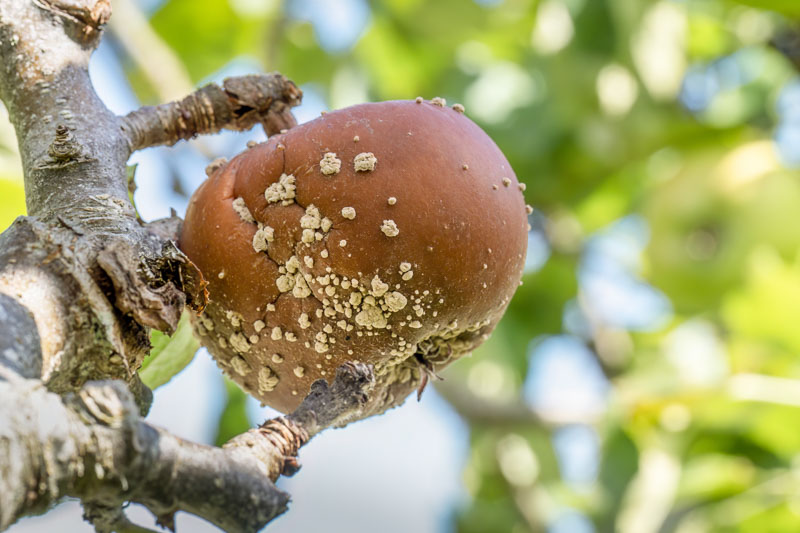What is Brown Rot?
Brown rot is a fungal disease that affects a wide range of fruit trees, including peaches, cherries, apricots, plums, and nectarines. It can also affect almond and plumcot trees.
It causes the fruit to rot and become covered with a velvety layer of tan or brown fungal spores. The disease can spread rapidly and affect entire orchards, resulting in significant crop losses if left untreated.
Brown Rot Life Cycle
The life cycle of brown rot fungi typically involves several stages, which include:
- Overwintering: The brown rot fungus survives the winter as fruiting bodies or spores in infected plant material or on the ground.
- Spore germination: In the spring, when conditions are right, the spores germinate and infect flowers, fruit, or other plant tissue.
- Infection: The fungus enters the plant through natural openings or wounds in the plant tissue. Once inside, it begins to grow and produce enzymes that break down the plant tissue, causing it to rot.
- Fruit rot: As the fungus grows and spreads, the infected fruit becomes soft, shriveled, and discolored. Eventually, the fruit dries out and turns to a mummy-like consistency.
- Spore production: As the fruit mummifies, the fungus produces spores, which are spread by wind, rain, or insects to other plants.
- Secondary infections: Secondary infections occur when the spores land on new plant tissue and germinate, starting the cycle again.
The life cycle of brown rot can vary depending on the specific species of the fungus and the plant it infects. However, most brown rot fungi follow a similar pattern of infection and spore production, which can be controlled through good cultural practices and the use of fungicides when necessary.
What Causes Brown Rot?
The disease is caused by several species of the fungus Monilinia, including Monilinia fructicola and Monilinia laxa. Here are some common factors that can contribute to its development:
- Warm, humid weather: Brown rot thrives in warm, humid conditions, which provide ideal conditions for the fungus to grow and spread.
- Wounded or damaged fruit or wood: Brown rot can enter a plant through wounds or other damage, such as cracks in the bark, pruning cuts, or insect damage. Once inside, the fungus can quickly spread and cause extensive damage.
- Overcrowding: Plants that are overcrowded or planted too closely together can create conditions that are conducive to rot development. This is because crowded plants have less air circulation, which can lead to higher humidity levels and a greater chance of infection.
- Poor sanitation: Brown rot can spread quickly from plant to plant, so it’s important to practice good sanitation in the garden. This means removing infected plant material and debris from the garden, disinfecting pruning tools between cuts, and avoiding working in wet conditions.
- Lack of sunlight: Plants that receive inadequate sunlight can be more susceptible to brown rot. This is because the fungus thrives in cool, damp areas, and shaded areas may stay moist longer than areas that receive more sun.
By taking steps to control these factors, gardeners can help prevent the development of brown rot and protect their plants from this destructive fungal disease.

What are the Symptoms?
- Blossom blight: Brown rot is first seen as brown spots on the blossoms in the spring, causing them to turn brown, wither, and die.
- Infected wood: The infection can grow into the woody tissue, producing cankers that may kill the entire twig.
- Infected fruit: This rot usually affects the fruit of plants first, causing it to become soft, shriveled, and discolored. The infected fruit may also develop a fuzzy gray or brown mold.
- Spore masses: In humid weather conditions, brown rot may produce spore masses on infected plant material. These spore masses are usually gray or brown and have a powdery or fuzzy appearance.
- Foul smell: Infected plant material may have a foul smell, which is caused by the breakdown of the plant tissue by the fungus.
How to Control and Prevent Brown Rot?
- Good sanitation: Brown rot can easily spread from infected plant material or debris left in the garden. It is important to remove and dispose of infected plant material properly. This includes removing fallen fruit, pruning out infected wood, and cleaning up any dead leaves or debris.
- Proper irrigation: Brown rot thrives in warm, humid conditions. To prevent infection, avoid watering plants overhead, which can lead to increased humidity. Instead, use drip irrigation or soaker hoses to water plants at the base.
- Pruning: Pruning trees to improve air circulation can reduce humidity levels and decrease the risk of infection. Proper pruning also helps remove any infected plant material that could spread the disease.
- Fungicides: When necessary, use fungicides to control brown rot. Fungicides should be applied according to the product label, and it is important to start early in the growing season before symptoms appear.
- Plant resistant varieties: Plant resistant varieties of fruit trees and other woody plants when possible. Resistant varieties are less susceptible to the disease and may not require as much fungicide application.
- Timely harvesting: Harvest fruit as soon as it ripens, and remove any fruit that is rotting or diseased. This reduces the amount of infected plant material left in the garden and can help prevent the spread of the disease.
By following these steps, gardeners can help prevent and control brown rot, protecting their fruit trees and other woody plants from this destructive disease.
While every effort has been made to describe these plants accurately, please keep in mind that height, bloom time, and color may differ in various climates. The description of these plants has been written based on numerous outside resources.
